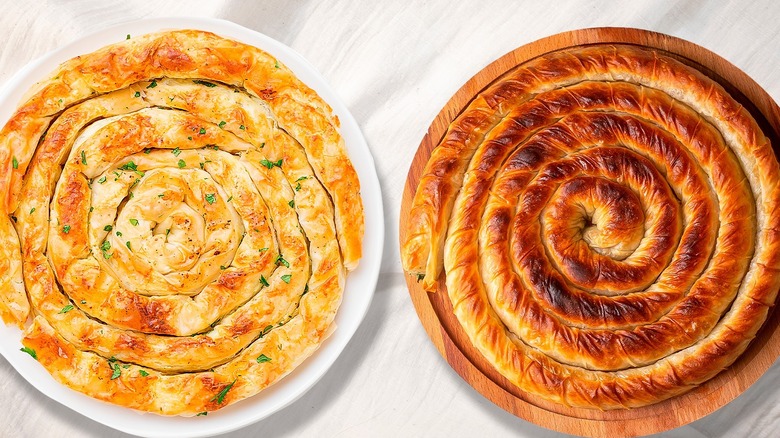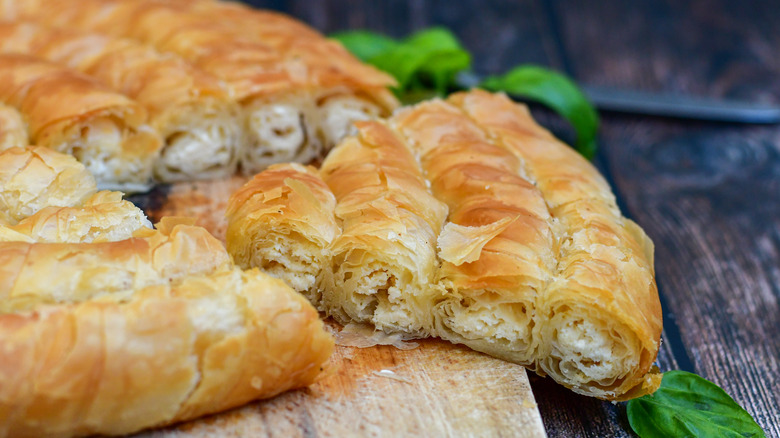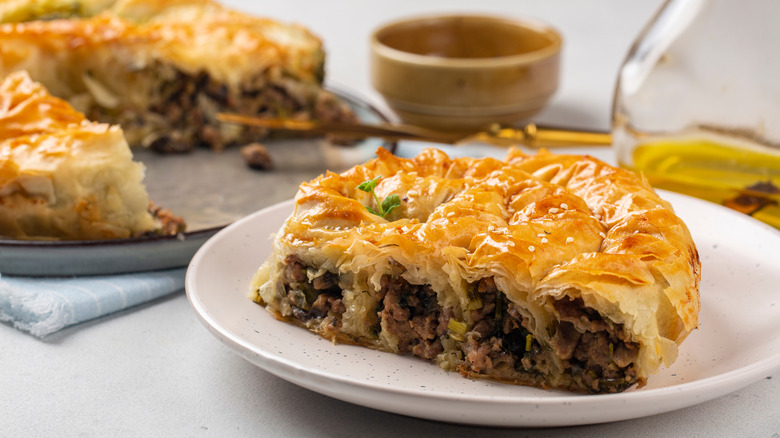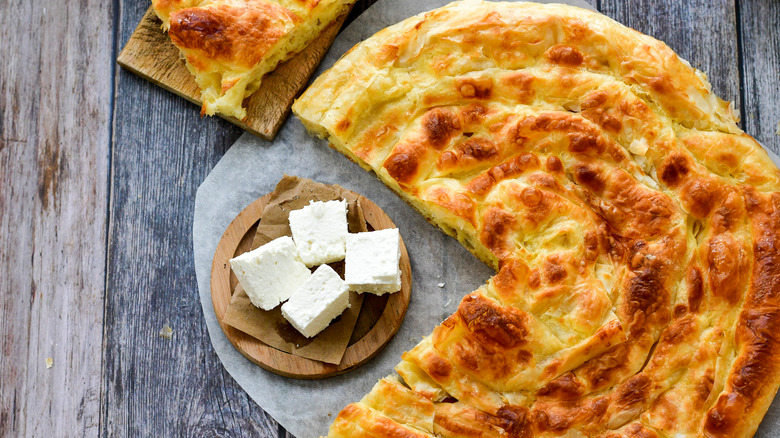What Makes Bulgarian Banitsa Different From Burek
While some dishes are confined to a specific cuisine, many intersect boundaries. Whether it's overlapping techniques or similar ingredient compositions, food is frequently carried from place to place. In a large swath of Eurasia, one popular overlapping food fare is the burek.
At its most simplified, burek is a pastry crafted from thin phyllo and stuffed with varying ingredients. Often enjoyed for breakfast or lunch alongside yogurt, it represents a comforting everyday meal. However, its cultural affiliations and expansive variety lend it a much richer background. Each of its consumed regions has transformed the dish with a regional twist, some far enough to become a distinct dish.
Such is the case for Bulgaria's banitsa, which resembles its predecessor but takes on a unique form. Crafted with sirene, a feta-like dairy product beloved in the nation, this country's rendition is extra cheesy and crispy. Its specified preparation, as well as serving, are a fascinating showcase of how food regionally develops.
What is Bulgarian banitsa?
Mouth-watering banitsa is one of Bulgaria's most treasured dishes. It consists of a thin layer of phyllo pastry stuffed with a mixture of cheese, eggs, and sometimes yogurt. The standard employed cheese is called sirene, a semi-hard variety reminiscent of feta. In combination with the eggs, the cheese melts in the oven and forms a soft and tasty filling, which lends banitsa its distinct character.
Additionally, banitsa has a specific spiral shape formed by a precise baking process. The filling is placed between layers of phyllo sheets before being carefully rolled into a spiral. The exterior develops a delectable golden crisp, and the resultant pie is sliced into pieces for serving. In customs during the New Year, Bulgarians often place small tokens and lucky charms throughout the pie, blessing those who receive a piece. Other times of the year, it's enjoyed as a breakfast, served alongside yogurt in numerous bakeries throughout the country.
What is burek?
Burek, alternatively spelled börek, is a centuries-old pastry prepared in an expansive array of cuisines. Most strongly associated with the Turkic culture, the nomadic people carried the preparation from Central Asia to present-day Turkey, Greece, the Balkan region of Europe, and parts of the Middle East. In each locale, the dish adopted a local flair, incorporating varying proteins, plants, cheeses, and other products abundant in the area.
Like banitsa, the pastry consists principally of a filling layered between sheets of phyllo. Especially in Bosnia, beef is a common burek filling, but fruits, cheeses, vegetables, and more can all make an appearance. And while assembly follows a similar format to banitsa, the resultant shape takes on a wider range of forms, like a cylinder or a pie-like appearance. It's a popular dish with many renditions, found in many bakeries, each offering its own spin. Consumed for any meal, but especially in the morning, burek is also served alongside yogurt for maximum satisfaction.
Banitsa is a specific regional specialty
Coming from a narrower range of origins, Bulgarian-made banitsa takes on specific cultural preparations. It's nearly always crafted into a spiral, as opposed to burek's varied shape. And with Bulgaria's disposition toward dairy — as evidenced by their unique yogurt — the cheese is a defining characteristic. Plus, Bulgarians associate the dish with specific holiday customs.
Banitsa likely stems from burek, but when the precise transformation occurred is unclear. Evidence points towards the 15th century, as this would align with the Ottoman occupation of the Slavic country, hence linking the dish to its Turkic origins.
In addition to Bulgaria, burek has transformed into new dishes in other regions, too. ln Greece, it emerged as tiropota, a cousin to banitsa made with feta. And in nearby Romania, a similar rolled pastry creation is called planica cu branza, often crafted with a thicker puff pastry. Plus, there are spin-offs in even more distant locales, like brik, a thin pastry stuffed with fish or meat, hailing from Northern Africa. Such far-reaching deviations showcase the evolving nature of the dish.
Burek takes on more varying forms than banitsa
For banitsa, the cheese, yogurt, and egg filling are the most classic and what many associate with the dish. Some local renditions do incorporate further ingredients, like sweet versions crafted with milk, as well as renditions with vegetables like leeks, onions, and cabbage. Nevertheless, banitsa's composition remains relatively constrained and dependably vegetarian in composition.
On the contrary, with burek's far-reaching scope, it comes in a dizzying array of forms. Even in one specific cuisine, like Croatian, the pastry includes recipes with a wide medley of meats, fruits, and vegetables. Walk into a buregdžinica — a Bosnian bakery specializing in burek — and discover everything from meat and cheese to potato, spinach, or fruit-filled exemplars.
Meanwhile, in Turkey, the filling and shape are regional in nature. Certain versions from Istanbul favor portability, stuffing meat, potatoes, and feta into a shortened roll. Meanwhile, the seaside city of Trabzon is known for its variant with anchovies. And with Turkey's mastery of sweets, no surprise there's a sweet burek, made in the neighboring Rize province. Such a selection is just the tip of the iceberg; throw in chefs consistently innovating the dish, and burek's exhaustive scope is evident.




